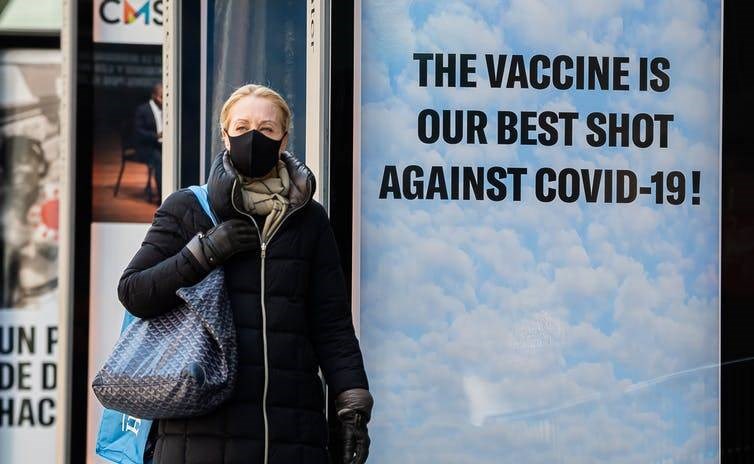By: William Petri, University of Virginia
When COVID-19 first began spreading, public health and medical experts began talking about the need for the U.S. to reach herd immunity to stop the coronavirus from spreading. Experts have estimated that between 60% and 90% of people in the U.S. would need to be vaccinated for that to happen. Only about 35% of the population has been fully vaccinated, and yet the CDC said on May 14, 2021 that fully vaccinated people can lose their masks in most indoor and outdoor settings.
An important question now arises: What happens if we don't reach herd immunity? Dr. William Petri is a professor of infectious diseases at the University of Virginia who helps lead the global program to achieve herd immunity for polio as the chair of the World Health Organization's Polio Research Committee. He answers questions here about herd immunity and COVID-19.
What is herd immunity?
Herd immunity occurs when there are enough immune people in a population that new infections stop. It means that enough people have achieved immunity to disrupt person-to-person transmission in the community, thereby protecting nonimmune people.
Immunity can result from either vaccination or prior infection. Herd immunity may exist globally, as it does with smallpox, or in a country or region. For example, the U.S. and many other countries have achieved herd immunity for polio and measles, even though global herd immunity does not yet exist.
Has herd immunity been achieved globally for other infections?
This has happened only once on a global scale, with the eradication of smallpox in 1980. This was after a decadelong worldwide intensive vaccination campaign.
We also are also approaching global herd immunity for polio. When the Global Polio Eradication Initiative was formed in 1988 there were 125 countries with endemic polio and over 300,000 children paralyzed annually. Today, after 33 years of immunization campaigns, Afghanistan and Pakistan are the only countries with wild polio virus, with only two cases of paralysis due to wild poliovirus this year. So herd immunity can be achieved worldwide, but only through extraordinary efforts with global collaboration. https://www.youtube.com/embed/RgYvwj_Q2M4?wmode=transparent&start=0 Dr. Anthony Fauci explains herd immunity at a hearing before Congress.
It seems as though the goal posts for herd immunity keep changing. Why?
Experts estimate that between 60% and 90% of the U.S. population would need to be immune for there to be herd immunity. This wide range is because there are many moving parts that determine what is needed to achieve herd immunity.
Factors influencing whether the target is 60% or 90% include how well vaccination and prior infection prevent not only illness due to COVID-19, but also infection and transmission to others. Additional considerations include the heightened transmissibility of new variants of SARS-CoV-2 and the use of measures to interrupt transmission, including face masks and social distancing. Other important factors include the duration of immunity after vaccination or infection, and environmental factors such as seasonality, population sizes and density and heterogeneity within populations in immunity.
What is the biggest barrier to herd immunity in the U.S.?
Two factors could lead to failure to achieve high enough levels of immunity: not every adult receiving the vaccine because of "vaccine hesitancy" and the likely need to vaccinate adolescents and children. The FDA cleared the emergency use of the Pfizer-BioNTech COVID-19 vaccine for adolescents 12 to 15 years of age on May 10, 2021, so that could help. But an added barrier is the constant pressure of reintroduction of infection from other countries where vaccination is not as readily available as in the U.S.
Achieving herd immunity to the extent of totally blocking new infections is therefore, while a laudable goal, not easily achievable. I think that for COVID-19 at this time, it will be possible only with the concerted global effort over years, similar to what led to smallpox eradication.
Why are there 'vaccine hesitant' individuals?
People may be vaccine hesitant for several reasons, including lack of confidence in the vaccine, the inconvenience of receiving the vaccine, or complacency — that is, thinking that if they get COVID-19 it will not be severe.
Lack of confidence includes concerns for vaccine safety or skepticism about the health care providers and public health officials administering them. Complacency reflects a personal decision that vaccination is not a priority for that individual because she or he perceives that the infection is not serious or because of competing priorities for time. Convenience issues include the availability and complexity, such as having to get two doses.
[Understand new developments in science, health and technology, each week. Subscribe to The Conversation's science newsletter.]
Since herd immunity will not be reached, what will our lives look like?
At least into 2022 and likely for much longer, I do not expect there will be herd immunity for COVID-19. What there will be, probably by the end of this summer in the U.S., is a new normalcy. There will be far fewer cases and deaths due to COVID-19, and there will be a removal of social distancing and year-round masking, as evidenced by the CDC's new guidelines issued May 13, 2021, that vaccinated people do not have to wear masks in most places.
But there will be a seasonality to coronavirus infections. That means there will be less in the summer and more in the winter. We'll also see outbreaks in regions and population subgroups that lack adequate immunity, short-lived lockdowns of cities or regions, new and more transmissible variants and a likely requirement for vaccine booster shots. We cannot let down on the research and development of treatments and new vaccines, as studies show that COVID-19 is here to stay.
William Petri, Professor of Medicine, University of Virginia
This article is republished from The Conversation under a Creative Commons license. Read the original article.




